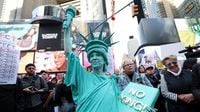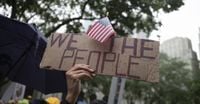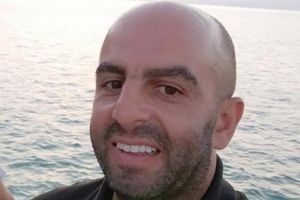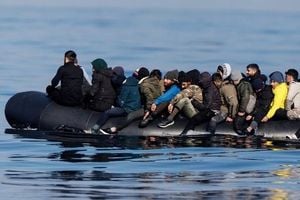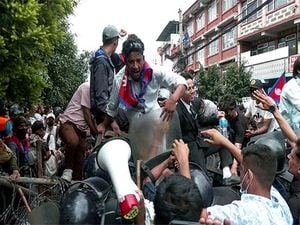On October 18, 2025, a sea of yellow-clad demonstrators flooded streets, parks, and public squares in cities and towns across the United States, marking what organizers called the "No Kings National Day of Action." From the steps of the Colorado State Capitol in Denver to Main Street in the small town of San Luis, Costilla County, and from Ithaca’s Washington Park to the bustling avenues of Washington, D.C., Americans of all ages and backgrounds gathered to protest the administration of President Donald Trump. According to organizers, this day was poised to be the largest single day of protest in American history, with more than 2,500 events planned nationwide.
The No Kings movement, spearheaded by a broad coalition of progressive and liberal groups—including the ACLU, Indivisible, MoveOn, Public Citizen, the American Federation of Teachers, and many others—called on the public to stand against what they described as Trump’s "authoritarian actions and power grabs." As reported by 9News and USA TODAY, these alleged actions included mass firings of federal workers, the freezing or cancellation of congressionally-authorized spending, and a dramatic escalation in immigration enforcement, all of which critics say undermine the constitutional separation of powers.
In Colorado alone, demonstrations were organized in dozens of communities, from Steamboat Springs to Lamar and Cortez. The largest rally in the state took place on the steps of the Capitol at noon, while smaller gatherings dotted rural towns. Organizers shared maps and resources online, urging participants to wear yellow as a symbol of unity and constitutional vigilance. The message was clear: "America has no kings, and the power belongs to the people," as stated on the movement’s website and echoed by protest signs and speeches nationwide.
The roots of the No Kings protests stretch back to June 14, 2025, when rallies were held in over 1,800 communities to coincide with Trump’s 79th birthday and the U.S. Army’s 250th anniversary parade in Washington, D.C. That day saw an estimated 5 million Americans take to the streets, but organizers and observers alike noted that the October 18 events surpassed even those numbers. Lisa Gilbert, co-president of Public Citizen, told USA TODAY, “This, without question, will be the single biggest day of protest in American history. Since we last did this, people have become far more aware of what is going wrong with this administration.”
While the protests were intended as a celebration of First Amendment rights—free speech, assembly, and dissent—they also served as a pointed rebuke of recent Trump administration policy moves. Chief among these were the deployment of National Guard troops to support Immigration and Customs Enforcement (ICE) operations in cities such as Chicago and Portland. President Trump described these cities as "war ravaged," a claim widely disputed by local officials and protesters, who pointed to the nonviolent nature of recent demonstrations, some of which featured inflatable animal costumes and even naked bicycle rides.
The rallies unfolded against a tense national backdrop. A government shutdown was ongoing, and federal troops had been deployed in several hotspots. According to Nexstar Media, Democrats across the country embraced the protests as an act of patriotic dissent, while Republican lawmakers denounced them as "hate America" rallies. House Minority Leader Hakeem Jeffries (D-N.Y.) stated on October 17, “Showing up to express dissent against an out-of-control administration, that’s as American as motherhood, baseball and apple pie.” In sharp contrast, House Majority Whip Rep. Tom Emmer of Minnesota accused Democrats of orchestrating the protests to "score political points with the terrorist wing of their party," as reported by USA TODAY.
Despite the heated rhetoric, organizers were emphatic about maintaining peace and safety. Local leaders underwent crowd safety and de-escalation training, and the ACLU distributed "Know Your Rights" resources to educate participants on lawful protest behavior. Weapons of any kind were strictly prohibited, and participants were urged to de-escalate confrontations and create a welcoming environment. As Lisa Gilbert explained, “We are taking to the streets to exercise our First Amendment rights and speak out. We are not planning anything in any way that could be misconstrued as violence. And we are working hard to protect people, providing lots of training and preparation and creating systems and mechanisms to make sure that people who turn out are safe.”
Live coverage from the ACLU and its partners showcased speeches from activists and legal experts in Washington, D.C., while livestreams and social media posts brought the events to millions who could not attend in person. The ACLU emphasized that, while the right to protest is constitutionally protected, law enforcement and ICE have not always respected those rights in practice. Sarah Hunt-Blackwell from the ACLU of Georgia encouraged nervous would-be protesters to "show up and be in community with other people," while Edwin Yohnka from the ACLU of Illinois urged attendees to "make tomorrow’s events a welcoming, safe, and supportive space for your community."
Colorado Attorney General Phil Weiser, a Democrat running for governor in 2026, was among those encouraging peaceful participation. Weiser, who has sued the Trump administration at least 37 times since January on issues ranging from withheld federal funding to attempts to end birthright citizenship, told 9News, “Show up at the No Kings rally on Oct. 18 at the Capitol — as many people as possible, and be as peaceful as possible. Don’t be afraid to show up, but also, we’ve got to be peaceful.”
Protests were not limited to major metropolises. In Ithaca and Trumansburg, New York, rallies were held at Washington Park and the Taughannock Giant, respectively. Across the country, from Boston and San Francisco to New Orleans and Bozeman, Montana, Americans gathered in both large urban centers and tiny rural towns. Organizers reported that the previous June 14 protests had remained peaceful, and they expected the same on October 18.
Yet, the deep political divide was impossible to ignore. While Democrats and civil rights groups celebrated the No Kings protests as a necessary defense of democracy, Republican leaders continued to level accusations of extremism and disruption. White House spokesperson Abigail Jackson, when asked for comment, replied simply, “Who cares?”
Despite the polarization and the tense national climate, the October 18 No Kings National Day of Action stood as a testament to the enduring power of collective protest in America. Organizers and participants alike left little doubt about their commitment to both their cause and to peaceful, lawful assembly—even as they confronted the challenges and risks that come with dissent in a divided country.
